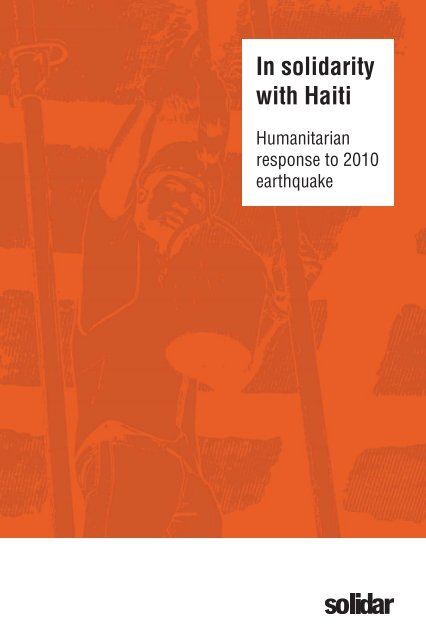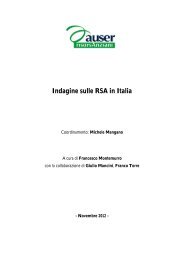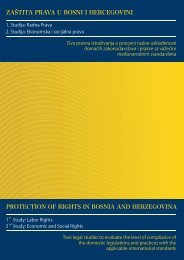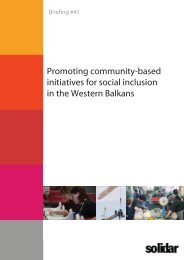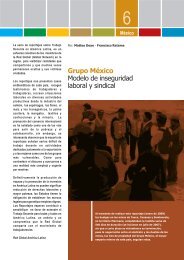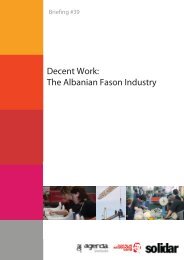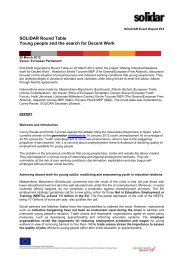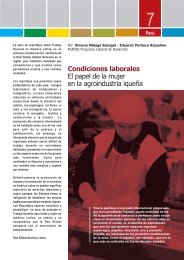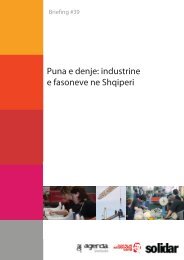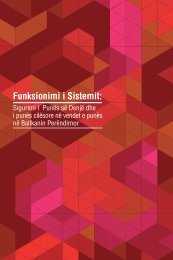In solidarity with Haiti: SOLIDAR humanitarian response to 2010 ...
In solidarity with Haiti: SOLIDAR humanitarian response to 2010 ...
In solidarity with Haiti: SOLIDAR humanitarian response to 2010 ...
You also want an ePaper? Increase the reach of your titles
YUMPU automatically turns print PDFs into web optimized ePapers that Google loves.
<strong>In</strong> <strong>solidarity</strong><br />
<strong>with</strong> <strong>Haiti</strong><br />
Humanitarian<br />
<strong>response</strong> <strong>to</strong> <strong>2010</strong><br />
earthquake
Contents<br />
Foreword 03<br />
1. Construction of two primary schools 04<br />
2. Better work for a decent reconstruction 11<br />
3. Economic, environmental and accessibility rehabilitation 19<br />
2.<br />
Better work for a decent<br />
reconstruction<br />
1.<br />
Construction<br />
of two primary schools<br />
The pictures illustrating this brochure are the result of a 2 week<br />
workshop on pho<strong>to</strong>graphy and graphic design which <strong>to</strong>ok place in<br />
Port-au-Prince in April 2013. 12 students, coming from different<br />
social and economic backgrounds, worked <strong>to</strong> improve their skills <strong>to</strong><br />
try and find their place as professional pho<strong>to</strong>graphers in <strong>Haiti</strong>. The<br />
potential and the motivation shown by these young students, their<br />
aim <strong>to</strong> improve and learn, shows that training and education are<br />
fundamental pillars for the reconstruction of a society.<br />
3.<br />
Economic, environmental and<br />
accessibility rehabilitation<br />
2
Foreword<br />
On the morning of 12 January <strong>2010</strong>, <strong>Haiti</strong> was hit by a devastating earthquake<br />
killing more than 220,000 people and making over 1.5 million homeless. <strong>In</strong><br />
the direct aftermath of the disaster, <strong>SOLIDAR</strong> members reacted in a surge of<br />
<strong>solidarity</strong> <strong>to</strong> provide assistance <strong>to</strong> the victims of the <strong>Haiti</strong>an earthquake, and<br />
<strong>to</strong> coordinate their relief action.<br />
<strong>SOLIDAR</strong> network members Norwegian People’s Aid, APHEDA Australia,<br />
Arbeiter-Samariter-Bund (ASB) Germany and ASB Austria, ARCI, Assamblea<br />
de Cooperacion Por la Paz Spain, MPDL Spain, Proget<strong>to</strong> Sud Italy, ISCOS<br />
Italy, Proget<strong>to</strong> Sviluppo – CGIL Italy, SASK Finland, Solidar Suisse,<br />
Solidaridad <strong>In</strong>ternacional Spain, Solidarité Laique France, Solidarité Syndicale<br />
Luxembourg and Volkshilfe Austria all worked <strong>to</strong>gether <strong>to</strong> increase the impact<br />
of their interventions.<br />
The <strong>SOLIDAR</strong> <strong>Haiti</strong> Solidarity Fund was set up <strong>to</strong> centralise the funds raised<br />
by <strong>SOLIDAR</strong> members from three countries – in particular Norwegian People’s<br />
Aid – in <strong>solidarity</strong> <strong>with</strong> <strong>Haiti</strong>. The Fund was then granted <strong>to</strong> three consortia of<br />
member organisations working in <strong>Haiti</strong>. This publication provides a detailed<br />
overview of the three initiatives that were carried out using these funds and<br />
the impact that they have had for the <strong>Haiti</strong>an people.<br />
<strong>SOLIDAR</strong> would like <strong>to</strong> thank all the people and organisations who so<br />
generously contributed <strong>to</strong> this <strong>solidarity</strong> fund and made it possible <strong>to</strong> help<br />
so many <strong>Haiti</strong>ans. Moreover, <strong>SOLIDAR</strong> would like <strong>to</strong> thank all those people<br />
engaged in the construction of the two primary schools, the economic,<br />
environmental and accessibility rehabilitation of ravines and roads and the<br />
‘Better Work for a Decent Reconstruction’ initiative. Through their relentless<br />
commitment we have been able <strong>to</strong> provide new opportunities for those<br />
hardest hit by the devastating earthquake.<br />
This publication is not only a tale of success, but also a call for increased<br />
engagement, as three years after the devastating disaster almost two<br />
million people (in particular women, children, nursing mothers) still face<br />
food insecurity and over 350,000 people are still living in camps waiting for<br />
<strong>humanitarian</strong> assistance.<br />
<strong>SOLIDAR</strong> member have not ended their <strong>solidarity</strong> actions - join us!<br />
Conny Reuter<br />
Secretary General<br />
3
1.<br />
© Barnabas Dieudonné<br />
4
Construction of two<br />
primary schools in<br />
Lotbou<strong>to</strong>u and Balan<br />
communities<br />
IMPLEMENTING ORGANISATION: MPDL, SPAIN<br />
Executive<br />
summary<br />
Achieved objective<br />
Improvement of the education system through the construction<br />
of two primary schools in Lotbou<strong>to</strong>u and Balan communities,<br />
municipality of Ganthier, <strong>Haiti</strong>.<br />
Achieved results<br />
1. Two schools of four classrooms each built, furnished, equipped<br />
and fully operative.<br />
2. Education for 560 students: organised and running at 83%<br />
(463 students).<br />
Total fi nal benefi ciaries<br />
The fi nal direct benefi ciary group consists of 519 people, 463<br />
of them are students (249 girls and 214 boys), 40 are teachers<br />
(22 men and 18 women), and 16 (12 women and 4 men) are the<br />
members of the Administrative Councils of the two schools of<br />
the communities of Balan and Lotbou<strong>to</strong>u. The improvements <strong>to</strong><br />
education will have a positive impact on the development of the<br />
communities. Therefore, a <strong>to</strong>tal of 800 families living in the Balan<br />
communities and a further 200 families living in the Lotbou<strong>to</strong>u<br />
communities have indirectly benefi ted from the current project.<br />
Detailed<br />
narrative<br />
report<br />
Location of the Balan and Lotbou<strong>to</strong>u communities<br />
During the fi rst months of the project, the team of selected technicians<br />
identifi ed possible sites for the construction of the schools in the two<br />
benefi ciary communities and organised the logistics necessary <strong>to</strong> guarantee<br />
the achievement of the expected results. The Balan and Lotbou<strong>to</strong>u communities<br />
5
were selected as sites for the schools because they not only hosted people<br />
displaced by the earthquake but were also directly hit by it.<br />
Balan community, located 5 km north-east of Ganthier, has a population of<br />
approximately 800 families <strong>with</strong> a fertility rate of 3.4 according <strong>to</strong> information<br />
published by UNICEF in 2009 1 , <strong>with</strong> 879 children (476 girls and 403 boys)<br />
of school age, according <strong>to</strong> information supplied by personnel in charge of<br />
the four existing schools in the area. The selected site measures 486 m² and<br />
belongs <strong>to</strong> Bethesda school in Balan.<br />
The main activity of the population is agriculture, though the community<br />
presents high levels of vulnerability. The inhabitants don’t have access <strong>to</strong> water<br />
and sanitation: water is supplied by springs (1 <strong>to</strong> 2 hours walking distance<br />
away) or trucks carrying drinking water. Approximately only 5-7% of houses<br />
have latrines, according <strong>to</strong> information gathered by Centro de Desarrollo<br />
Sostenible (CEDESO) staff. Due <strong>to</strong> the earthquake in January <strong>2010</strong>, about 200<br />
families moved in<strong>to</strong> the community from Port-au-Prince, increasing the needs<br />
that already existed in the area.<br />
Through this project, it was decided <strong>to</strong> rebuild and enlarge the Bethesda<br />
school in Balan. The selection of the new school’s site was based on safety,<br />
land availability and access. The community’s members, local authorities<br />
and the school direc<strong>to</strong>r were consulted in order <strong>to</strong> have the support of the<br />
population and <strong>to</strong> ensure that the new building site, as well as the building<br />
itself, would meet international anti-seismic standards, and offer adequate<br />
coverage <strong>with</strong> respect <strong>to</strong> population growth. According <strong>to</strong> these standards,<br />
schools and healthcare centres must be used as shelters for people in the<br />
event of a disaster (such as an earthquake). Therefore, it was fundamental <strong>to</strong><br />
select a site <strong>with</strong> no risk of flooding, no landslide hazards, and close <strong>to</strong> the<br />
beneficiary population.<br />
The Lotbou<strong>to</strong>u community is located near <strong>to</strong> the <strong>to</strong>wn of Ganthier, 1 km <strong>to</strong><br />
the west on the other side of the river, as its name means in Creole. The<br />
community consists of about 200 families and about 150 children of school<br />
age (90 girls and 64 boys). Like Balan, Lotbou<strong>to</strong>u hosted people displaced<br />
after the January <strong>2010</strong> earthquake, who then settled in the areas around the<br />
community.<br />
The main activities of the population are farming and trading. There is no<br />
sanitation service in this community. Thanks <strong>to</strong> its proximity <strong>to</strong> the <strong>to</strong>wn<br />
centre, water is supplied <strong>to</strong> the community through a pipe system from the<br />
nearby river, but the water is not potable.<br />
After several inquiries conducted <strong>with</strong> the population and <strong>with</strong> the support<br />
of the local authorities, it has been decided <strong>to</strong> build the school in an area of<br />
1140 m² belonging <strong>to</strong> the Fraternité Chrétienne (Christian Friendship) school<br />
of Lotbou<strong>to</strong>u, taking in<strong>to</strong> account ease of access for the displaced population<br />
that lives on the border of the urban areas, as well as safety conditions and<br />
land availability.<br />
1<br />
More information:<br />
http://www.unicef.org/spanish/<br />
infobycountry/haiti_statistics.html<br />
As in the previous case, the choice of improving an existing infrastructure<br />
guarantees the sustainability of the project, since this school complies <strong>with</strong><br />
the requirements of the <strong>Haiti</strong>an Ministry of Education and it has the support<br />
of the local people involved in its management and running.
Results and difficulties encountered during the construction<br />
Works ended in December 2011. The schools have been built: two schools<br />
of four classrooms each, one office, two bathrooms and a s<strong>to</strong>rage room,<br />
distributed across two floors. The buildings meet international standards as<br />
schools and healthcare centres are <strong>to</strong> be used as shelters for the population<br />
in case of events that could endanger the lives of the inhabitants.<br />
The earthquake-resistance of the schools is guaranteed. The buildings are<br />
also resistant <strong>to</strong> hurricanes and phenomena such as floods, strong winds,<br />
landslides, etc., which are quite frequent in the area of intervention.<br />
With respect <strong>to</strong> the building process it is worth underlining the following<br />
aspects:<br />
• Strong community <strong>response</strong>: there was great commitment <strong>to</strong> completing<br />
both buildings. To give an example: the Lotbou<strong>to</strong>u community helped in<br />
manually transporting the building material <strong>to</strong> the working site, due <strong>to</strong> the<br />
fact that its location on the other side of the river makes it inaccessible<br />
<strong>to</strong> trucks or other machinery. This achievement required a big community<br />
effort.<br />
• Active commitment of Ganthier´s mayor, Mr. Ralf Lap<strong>to</strong>ine from the<br />
beginning of the project. The mayor continues <strong>to</strong> collaborate in the decision<br />
making process, and facilitate relations <strong>with</strong> the <strong>Haiti</strong>an State and the Border<br />
Security Force <strong>with</strong> respect <strong>to</strong> the transport of materials.<br />
It is also important <strong>to</strong> underline the following difficulties:<br />
© Fabienne Douce<br />
• Delays in delivering building materials due <strong>to</strong> the fact that <strong>Haiti</strong> is mainly<br />
dependent on goods supplied and transported by land from the Dominican<br />
Republic. This fact has drastically increased border traffic and therefore the<br />
waiting time for goods in transit. Eventually, it was possible <strong>to</strong> obtain special<br />
permission from several Dominican-<strong>Haiti</strong>an governmental institutions.<br />
• The foundations of the schools needed <strong>to</strong> be reinforced <strong>with</strong> three extra<br />
rows of blocks, increasing the amount of building material, due <strong>to</strong> the<br />
nature of the selected sites.<br />
• Due <strong>to</strong> the limited dimensions of the land available, it was necessary <strong>to</strong> build<br />
the schools on two floors, <strong>to</strong> allow enough space for outdoor activities.<br />
• Lack of water supply and other services such as electricity represented<br />
a big challenge in the project implementation, despite the great support,<br />
commitment and effort of all stakeholders.<br />
<strong>In</strong> Balan, water was initially supplied by trucks, which actually was another<br />
fac<strong>to</strong>r delaying the progress of the work. Nevertheless, by the end of the<br />
project, it was possible <strong>to</strong> install tanks supplied by a power unit. <strong>In</strong> view<br />
of the fact that the public water grid doesn’t supply water on a regular and<br />
constant basis, the new education centre has shown it is fully committed<br />
<strong>to</strong> the efficient use of water in order <strong>to</strong> guarantee full coverage in the<br />
community.
© Barnabas Dieudonné © Barnabas Dieudonné<br />
<strong>In</strong> Lotbou<strong>to</strong>u, as a short-term solution <strong>to</strong> the water supply issue, technicians<br />
connected the school <strong>to</strong> the public grid, although only 10% of the population<br />
has direct access <strong>to</strong> the aqueduct. By the end of the project, it was possible <strong>to</strong><br />
install three tanks of 530 gallons each, supplied by gravity, which guarantee<br />
water for drinking and sanitation.<br />
Capacity building of the teachers from the two schools<br />
As planned, six workshops were run <strong>with</strong> direc<strong>to</strong>rs and teachers from the two<br />
schools and additionally teachers from the community school in San<strong>to</strong> 12<br />
district. The workshops covered the following <strong>to</strong>pics:<br />
• Managing educational systems in the <strong>Haiti</strong>an emergency context –<br />
Participants: 40 teachers (16 women and 24 men), 6 of them from the<br />
communitary school in San<strong>to</strong> 12 district. Subjects: identification of<br />
stakeholders involved in the management of the education system and <strong>to</strong>ols<br />
for proper management.<br />
• Psychological and emotional support <strong>to</strong> children addressed <strong>to</strong> teachers,<br />
direc<strong>to</strong>rs and volunteers – Participants: 38 teachers (9 women and 29<br />
men), 6 of them from the community school in San<strong>to</strong> 12 district. Subject:<br />
the role of teachers in the psycho-affective learning process of the students;<br />
fac<strong>to</strong>rs associated <strong>with</strong> the student behaviour, assessment of situations and<br />
<strong>to</strong>ols analysis that can improve social skills <strong>with</strong>in the school environment.<br />
• Education for human development – Participants: 35 teachers (11 women<br />
and 24 men), 6 of them from the community schools of San<strong>to</strong> 12 district.<br />
Subjects: group analysis of the importance of education as a development<br />
<strong>to</strong>ol, especially in the <strong>Haiti</strong>an context; debates on new educational models<br />
and leadership in the event of emergency.<br />
• Popular teaching techniques and alternative approaches – Participants: 39<br />
teachers (11 women and 28 men), 7 of them from the community school<br />
of San<strong>to</strong> 12 district. Subjects: how popular education can contribute <strong>to</strong><br />
community development.<br />
• Risk prevention at school – Participants: 36 teachers (9 women and 27<br />
men), 6 of them from the community school of San<strong>to</strong> 12 district and 3 from<br />
Children’s Dream Centre in Leogane. Subjects: preparation of teachers for<br />
the prevention and mitigation of risks. Group dynamics were used <strong>to</strong> identify<br />
the main risks in the <strong>Haiti</strong>an context and establish <strong>response</strong> strategies.<br />
• Healthy habits for the prevention of Health risks – Participants: 39 teachers<br />
(10 women and 29 men), 6 of them from the community school of San<strong>to</strong><br />
12 district. This session was held during the cholera outbreak in <strong>Haiti</strong>,<br />
therefore the trainer focused the workshop on hygiene and good practices<br />
<strong>to</strong> prevent cholera. During this workshop, the fact that schools have a water<br />
supply and sanitation systems was seen as a major step in the communities’<br />
development by participants, especially when considering the insufficient<br />
and poor sanitation coverage (basic latrines). Moreover, participants valued<br />
very positively the efforts made by the project <strong>to</strong> include a capacity building<br />
session for teachers and <strong>to</strong> promote events for public debates on the reality<br />
of the situation they face.
Updated schools register and new education plan<br />
Both schools have had a new enrolment register since the beginning of the<br />
academic year (Oc<strong>to</strong>ber <strong>2010</strong>), hence, complete lists of enrolled students<br />
are available. However, according <strong>to</strong> the information collected, teachers<br />
don’t have a personal register for each student. Thanks <strong>to</strong> the current<br />
project, teachers are now able and can manage a pedagogical system such<br />
that they can keep track of the educational his<strong>to</strong>ry of each student. They<br />
began compiling data from January 2012, <strong>with</strong> the opening of the new<br />
education centres.<br />
A special workshop for the presentation of the new education plan was<br />
held in December, just after the opening of new centres. Previously, the<br />
Board of Direc<strong>to</strong>rs of both schools defined the 2012 school calendar and<br />
established agreements for the incorporation of the two centres in<strong>to</strong> the<br />
education curricula of the <strong>Haiti</strong>an Ministry of Education. The presentation<br />
of the new education plan <strong>to</strong> the communities was attended by 23 people,<br />
including teachers, direc<strong>to</strong>rs, and parents and community leaders. This<br />
plan has begun <strong>to</strong> be put in practice as of the beginning of this year.<br />
Resumption of classes<br />
Classes restarted in Oc<strong>to</strong>ber <strong>2010</strong>, held in the makeshift shelters that were<br />
available at the time, which meant that in both academic year <strong>2010</strong>-2011 and<br />
2011-2012, educational activities were running and school registers were<br />
updated. During these two academic years, enrolment began in September,<br />
while activities (classes) began in the first half of Oc<strong>to</strong>ber. School staff,<br />
<strong>to</strong>gether <strong>with</strong> support from the technical team, have developed the education<br />
services offered by the two schools <strong>to</strong> the enrolled students. <strong>In</strong> September<br />
2011, faced <strong>with</strong> the political uncertainty surrounding the new government<br />
and the beginning of the academic year, both schools launched a campaign <strong>to</strong><br />
encourage children and teenagers <strong>to</strong> re-enrol in school. Each school received<br />
students for their enrolment and/or re-enrolment. <strong>In</strong> January 2012, the two<br />
schools began classes as usual in the newly built centres. The schools have<br />
now achieved 65% capacity. It is expected that coverage will be extended<br />
<strong>with</strong> the new academic year (2012-2013), when the new schools will be<br />
incorporated in<strong>to</strong> the official curricula and a sensitising campaign will have<br />
been completed.<br />
Direct beneficiaries<br />
The direct beneficiary group consists of 519 people of which: 463 are<br />
students (249 girls and 214 boys); 40 are teachers (18 women and 22 men);<br />
16 are parents (12 women and 4 men), and the remainder members of the<br />
two Boards of the schools.<br />
<strong>In</strong>direct beneficiaries<br />
The improvements <strong>to</strong> education will have a positive impact on the development<br />
of the Lotbou<strong>to</strong>u and Balan communities. Therefore, the indirect beneficiaries<br />
were/are the inhabitants of the two communities, namely, 1,000 displaced<br />
© Willy Mésidor © Willy Mésidor © Willy Mésidor
families (800 in Lotbou<strong>to</strong>u and 200 in Balan). Moreover, positive impacts<br />
are expected on the education services of the community schools in San<strong>to</strong><br />
12 district, thanks <strong>to</strong> the teachers that participated in the training offered by<br />
this project.<br />
Sustainability of the action<br />
© Fabienne Douce © Willy Mésidor<br />
The project has been defined and implemented so that services and benefits<br />
will be maintained throughout the horizon of life.<br />
1.<br />
2.<br />
3.<br />
Technical sustainability. The project has increased and strengthened<br />
the management skills of the people responsible for the management<br />
of the two schools and the professional skills of the people responsible<br />
for educational activities.<br />
Economic sustainability. Both schools are based on self-management<br />
models, which mean that the communities are fully in charge of their<br />
management. During the project, the two schools began the process<br />
of being incorporated in<strong>to</strong> the Ministry of Education Curricula, which<br />
implies that in future both centres can apply for public funding.<br />
Moreover, during meetings <strong>with</strong> the BoM possible solutions for<br />
generating future revenue were discussed, and Centro de Desarrollo<br />
Sostenible (CEDESO) staff and the Municipality of Ganthier have<br />
begun looking for opportunities <strong>to</strong> develop appropriate action.<br />
Social sustainability. One of the great achievements of this intervention<br />
was the integration and mobilisation of different stakeholders in<br />
each phase of the project (schools’ designing and building, etc). It<br />
is also important <strong>to</strong> mention the involvement of the local authorities<br />
in the project, namely the mayor of Ganthier, who has participated<br />
intensively in the negotiations <strong>with</strong> <strong>Haiti</strong>an institutions and cus<strong>to</strong>m<br />
officers in order <strong>to</strong> facilitate the import and transport of materials<br />
across the border, as well as following meetings <strong>with</strong> beneficiary<br />
communities.<br />
Therefore, the current project has laid the foundations for the improvement of<br />
the quality education in <strong>Haiti</strong> in the medium and long term.<br />
10
2.<br />
© Moïse Pierre<br />
11
Better work for a decent<br />
reconstruction<br />
IMPLEMENTING ORGANISATION: ISCOS, ITALY<br />
Achieved objectives<br />
•<br />
A training programme on the building<br />
sec<strong>to</strong>r focused on the empowerment of<br />
worker’s skills for bricklayers, electricians,<br />
and plumbers, <strong>to</strong> improve their<br />
abilities and <strong>to</strong> stress the importance of<br />
safety rules in construction areas and in<br />
the building process.<br />
A vocational training course and a methodological<br />
training course for trainers of<br />
building workers.<br />
Better reconstruction: a campaign for safe<br />
work during relief and reconstruction fo-<br />
•<br />
•<br />
cused on four different subjects and using<br />
different channels of communication.<br />
• Seminars on trade union empowerment,<br />
strategic positioning, collective bargaining<br />
and affiliation <strong>to</strong> trade unions organised<br />
in collaboration <strong>with</strong> CASC, INFAS<br />
and INFOSCAR and UTAL.<br />
• Seminars on the promotion of services<br />
for workers by trade unions, especially<br />
for informal workers in the building sec<strong>to</strong>r,<br />
organised in collaboration <strong>with</strong> the<br />
ITUC and TUCA.<br />
Executive<br />
summary<br />
Achieved results<br />
•<br />
28 trainers for masons trained in certified<br />
courses.<br />
175 building workers (bricklayers) trained<br />
in certified courses.<br />
75 building workers (electricians) trained<br />
in certified courses.<br />
50 building workers (plumbers) trained in<br />
certified courses.<br />
50 building workers’ organisations fully<br />
trained and aware of the importance of<br />
safety at work and accident prevention.<br />
500 employers and civil servants trained<br />
through workshops on safety at work.<br />
•<br />
•<br />
•<br />
•<br />
•<br />
• One campaign <strong>to</strong> raise awareness of<br />
health and safety at work, <strong>Haiti</strong>an labour<br />
code, safety rules in building areas<br />
through the purchase and dissemination<br />
of materials such as documents, brochures,<br />
pamphlets, a new website, and<br />
through the mass media (television, radio,<br />
newspapers), at least 100,000 workers<br />
made aware.<br />
• Rehabilitation/Equipment of a vocational<br />
trade union centre for the three above<br />
mentioned areas.<br />
Total fi nal benefi ciaries<br />
More than 330 building workers, more than 500 employees, employers and civil<br />
servants.<br />
12
Direct beneficiaries reached<br />
More than 330 building workers, more than 500 employees, employers and<br />
civil servants.<br />
Constitution of a managing committee<br />
Detailed<br />
narrative<br />
report<br />
Since the beginning of the project activities, on 15 February 2011, the<br />
consortium leader, <strong>to</strong>gether <strong>with</strong> the partners, has organised at least<br />
one monthly meeting in order <strong>to</strong> be able <strong>to</strong> identify a reference person<br />
for each organisation involved in the project and <strong>to</strong> agree the timeline<br />
of implementation of the activities. Romain Winsler and Ginette Apollon<br />
were identified by the <strong>Haiti</strong>an workers’ confederation (CTH) as persons<br />
of reference, respectively as Coordina<strong>to</strong>r and Administrative Secretary,<br />
while the Au<strong>to</strong>nomous Classist Trade Union Confederation (CASC) of<br />
the Dominican Republic appointed Esperidon Villa Paredes, Direc<strong>to</strong>r of<br />
INFAS (National Training <strong>In</strong>stitute for Agriculture and Social Studies), who<br />
supervised the training programmes. The first outcome of these meetings<br />
was the establishment and signature of a Memorandum of Understanding<br />
among the Consortium and the partners, on 27 March 2011.<br />
Signature of memorandum of understanding for the coordination<br />
<strong>with</strong> ITUC – TUCA and ILO<br />
The Consortium remained in constant communication on project activities<br />
and strategies <strong>with</strong> the appointed reference persons of the ITUC-TUCA<br />
(<strong>In</strong>ternational Trade Union Confederation – Trade Union Confederation for<br />
the Americas) and the ILO (<strong>In</strong>ternational Labour Organisation). <strong>In</strong> particular,<br />
Isabelle Hoferlin, ITUC Coordina<strong>to</strong>r for Latin America and Caribbean, acted<br />
as a reference person for all the trade union institutes involved in the<br />
reconstruction and development of <strong>Haiti</strong>, constantly updating and sharing<br />
information among the institutes <strong>to</strong> give them the opportunity <strong>to</strong> identify<br />
synergies and avoid overlapping.<br />
The Secretary General of TUCA, Vic<strong>to</strong>r Baez, and his officers, Leandra<br />
Perpetuo, Area Coordina<strong>to</strong>r, and An<strong>to</strong>ny Jones, former Project manager in<br />
<strong>Haiti</strong>, worked on a joint trade union programme <strong>to</strong> be implemented under<br />
the supervision and executive coordination of TUCA and the ILO.<br />
Finally, on behalf of a consortium composed of IPEC (<strong>In</strong>ternational<br />
Programme on the Elimination of Child Labour), TUCA and CTH, An<strong>to</strong>nio<br />
Cruciani, Senior Socio-Economic Recovery Specialist, ILO/CRISIS in <strong>Haiti</strong>,<br />
and An<strong>to</strong>ny Jones delivered a pilot project on vocational training for teen<br />
workers (14-18 years old) interested in working in construction. The<br />
courses were held at INAFOS (Vocational Training National <strong>In</strong>stitute for<br />
Social Studies), the CTH training centre.<br />
Moreover, during one of the field missions, the Consortium had a meeting<br />
<strong>with</strong> An<strong>to</strong>ny Jones, who agreed <strong>to</strong> take part in the project as a member of<br />
the management committee on behalf of TUCA. During the meeting, it was<br />
possible <strong>to</strong> analyse in depth the strategic direction of the programme that<br />
13
had <strong>to</strong> be implemented in coordination <strong>with</strong> all the trade union institutes<br />
operating on the <strong>Haiti</strong>an scene, <strong>to</strong>gether <strong>with</strong> ILO and ITUC-TUCA, in order<br />
<strong>to</strong> identify programme synergies and operational efficiencies.<br />
Vocational training and methodological training of trainers for<br />
building workers<br />
Before the implementation of the courses, the local project staff agreed on<br />
the implementation of preliminary research that was successfully delivered<br />
and included:<br />
• INFOTEP (National <strong>In</strong>stitute for Technical Professional Training in Dominican<br />
Republic) and the National <strong>In</strong>stitute for Professional Training (INFP)<br />
regulation and requisites of the courses <strong>to</strong> be certified (modules, number of<br />
hours/course, minimum requisites of the participants);<br />
© Moïse Pierre<br />
• Making the CTH’s trade union training center (INAFOS) a certified operative<br />
centre of the National <strong>In</strong>stitute for Professional Training (INFP): collecting<br />
documents and the application form for the request of a INFP officers<br />
moni<strong>to</strong>ring mission;<br />
• Collecting <strong>Haiti</strong>an regulations for the construction project designs at the<br />
National Labora<strong>to</strong>ry;<br />
• Verifying the availability on the labour market of foremen, trained in <strong>Haiti</strong><br />
and their level of education, courses taken and experience;<br />
• Making a list of at least 30 persons interested in working as a trainer and<br />
getting the proper training. The basic requisites were: maximum 40 years old,<br />
minimum 8 th grade, basic knowledge of masonry, electricity, plumbing (at<br />
least two subjects each). During the selection process, the staff guaranteed<br />
equal opportunities <strong>to</strong> all candidates coming from all regions and affiliated<br />
<strong>to</strong> each of the <strong>Haiti</strong>an trade unions and the widest representation of them.<br />
• Filling in the proper application forms for each candidate and keeping<br />
records of all the supporting documentation.<br />
The training of trainers in the <strong>SOLIDAR</strong> project stems from the need <strong>to</strong> move<br />
from an empirical knowledge of most of the <strong>Haiti</strong>an construction trainers<br />
<strong>to</strong>wards a technical one, through two professional updates, the first technical<br />
(i.e. related <strong>to</strong> the issues of construction) and the second on methodology<br />
issues (relative <strong>to</strong> educational subjects and andragogical techniques).<br />
However, the analysis carried out by the local coordina<strong>to</strong>r Esperidon Villa,<br />
National <strong>In</strong>stitute for Technical and Professional Training of the Dominican<br />
Republic (INFOTEP) construction trainer for 20 years, as well as a prominent<br />
figure in the Dominican trade union FETRACON, highlighted gaps both<br />
in the field of technical qualifications (interpretation of building plans, site<br />
safety and prevention, and administration of the site), and especially in the<br />
methodological ones. As a consequence, the time and cost of the project<br />
activity “training of trainers” (which were significantly reduced when the need<br />
<strong>to</strong> redesign the project budget arose) proved <strong>to</strong> be widely underestimated<br />
compared <strong>to</strong> the real needs.<br />
14
The activity “training of trainers” <strong>to</strong>ok place as follows:<br />
• Part A Technical Skills, INAFOS Port au Prince: 3 weeks, from 10 Oc<strong>to</strong>ber <strong>to</strong><br />
27 November, 15 participants, teachers from National <strong>In</strong>stitute for Technical<br />
and Professional Training of the Dominican Republic (INFOTEP).<br />
• Part B Methodological skills, INFAS San<strong>to</strong> Domingo: 2 weeks, from<br />
1 November <strong>to</strong> 30 November, almost 10 participants, teachers from<br />
INFOTEP and INFAS.<br />
• Part C Moni<strong>to</strong>ring of “training of trainers”: 10 day mission from an Italian<br />
expert of Proget<strong>to</strong> Sud - Uil.<br />
As for the above-mentioned schedule, the Course for Foremen and the<br />
Methodological workshop were held respectively on 10-27 Oc<strong>to</strong>ber at the CTH’s<br />
trade union training center (INAFOS) and 14-30 November at National <strong>In</strong>stitute<br />
of Union and Agrarian Formation (INFAS) of Dominican Republic. All the training<br />
materials of both courses, provided by INFAS and INFOTEP (National <strong>In</strong>stitute for<br />
technical and Professional Training), were translated in<strong>to</strong> French and formed part<br />
of the training kit distributed <strong>to</strong> each participant on the course.<br />
Moreover, the Consortium, through INFAS and its Direc<strong>to</strong>r, reached an agreement<br />
<strong>with</strong> INFOTEP for the certification of both courses and the curricula and the scores<br />
of each participant are currently being evaluated. INFOTEP also guaranteed its<br />
support both on the teaching side, authorising INFAS Direc<strong>to</strong>r Esperidon Villa<br />
Paredes, <strong>to</strong> take part as a trainer in the first stage of the “training of trainers”,<br />
and approving the translation of their materials; while on the financial side, they<br />
contributed <strong>to</strong> covering the salary of the methodological skills trainer. During the<br />
Methodological Course at INFAS, the Minister of Labour of Dominican Republic,<br />
Dr. Francisco Dominguez Bri<strong>to</strong>, wanted <strong>to</strong> show his support for the joint effort<br />
of the Dominican and <strong>Haiti</strong>an trade unions by personally visiting the participants<br />
during their class and interviewing them about the training programme.<br />
Finally, it is worth mentioning that CTH contributed through its resources and<br />
other international funding, <strong>to</strong> the financial effort behind this activity. That<br />
commitment allowed the Consortium <strong>to</strong> expand the <strong>to</strong>tal group of participants<br />
in the activity <strong>to</strong> 28 members, compared <strong>to</strong> the 15 initially planned for the first<br />
stage (at INAFOS in Port au Prince (<strong>Haiti</strong>)), and the 10 for the second one (at<br />
INFAS in San<strong>to</strong> Domingo (Dominican Republic)).<br />
Certified training courses for bricklayers, electricians and<br />
plumbers<br />
Manuals and programmes creation<br />
The lack of skilled labour stems from the low level of training and the<br />
deficiency of the teaching materials. Therefore after the activity aimed at<br />
complementing and enriching the trainer’s skills, the Consortium faced<br />
another crucial corners<strong>to</strong>ne in the life of this project: the creation of a high<br />
quality level teaching kit, adapted <strong>to</strong> the <strong>Haiti</strong>an situation.<br />
The Programmes for the trainers and the manuals for the participants, adapted<br />
<strong>to</strong> the premises, were conceptualised and written by a team of expert trainers<br />
15
from FETRACON, the sec<strong>to</strong>rial association of building workers affiliated <strong>to</strong><br />
CASC, under the supervision of the Secretary General and Direc<strong>to</strong>r of INFAS,<br />
Esperidon Villa Paredes. They created this teaching kit following the INFOTEP<br />
training scheme, taking advantage of the experience acquired during the<br />
training of trainers, when Mr Villa managed both courses, in order <strong>to</strong> adapt<br />
the original ideas <strong>to</strong> the needs in <strong>Haiti</strong>.<br />
Manuals and programmes translation<br />
The translation of the materials in<strong>to</strong> French was another crucial aspect. Given the<br />
complications arising from the initial decision <strong>to</strong> deliver the translation <strong>to</strong> a <strong>Haiti</strong>an<br />
professional transla<strong>to</strong>r <strong>with</strong>out technical skill, the Consortium finally decided <strong>to</strong><br />
take advantage of the kind availability of a French mother <strong>to</strong>ngue volunteer, Ms<br />
Evelyn Chevalier, <strong>with</strong> the technical advice of an expert <strong>Haiti</strong>an foreman, Mr Jean<br />
Robert Casimir, who revised and completed the initial translation. This process<br />
<strong>to</strong>ok a couple of months, but the Consortium considered the quality of the<br />
material was worth spending all the necessary time on.<br />
Delivery of certificates and induction of the trainers, selection of the<br />
areas and trainers per area<br />
The training for masons, electricians and plumbers started <strong>with</strong> a two day<br />
event under the supervision of Mr Villa and <strong>with</strong> the participation of the<br />
project staff, the partners’ staff, the ILO representative, Amy Roadhes and all<br />
the 28 trainers. First of all, the trainers got their technical and methodological<br />
certificates, issued by INFAS and INFOTEP, during a formal ceremony followed<br />
by a press conference. Then, the trainers faced two days of induction and<br />
planning. During the activity, the project staff decided <strong>to</strong> give <strong>to</strong> all the trainers<br />
the chance <strong>to</strong> participate in the courses, in order <strong>to</strong> acquire the necessary<br />
experience and enrich their CVs. Moreover, the training was then extended<br />
throughout the country, for a <strong>to</strong>tal of six departments.<br />
The following departments and subjects were covered:<br />
1. Port au Prince, 2 courses on masonry and 1 on electricity;<br />
2. Cap <strong>Haiti</strong>enne, 1 course on masonry and 1 course on plumbing;<br />
3. St. Marc, 1 course on masonry and 1 course on plumbing;<br />
4. Petit Goave, 1 course on masonry and 1 course on electricity;<br />
5. Les Cayes, 1 course on masonry and 1 course on electricity;<br />
6. Jeremie, 1 course on masonry.<br />
12 courses, 25 participants in each course, making a <strong>to</strong>tal of 300<br />
beneficiaries.<br />
Preparation of the evaluation sheets for the selection<br />
The final 25 participants for each course were chosen during a process of<br />
technical selection among at least 30 candidates. INFAS <strong>to</strong>ok responsibility<br />
for preparing the exams for each category of subject, the instructions and<br />
for deciding the scores <strong>to</strong> be applied, while the project staff translated them<br />
in<strong>to</strong> French.<br />
Selection of the beneficiaries<br />
The local staff in the different departments <strong>to</strong>gether <strong>with</strong> the trainers started a<br />
campaign promoting the next launch of the training programme and the technical<br />
16
equirments: From 18 <strong>to</strong> 45 years old; Primary education; Knowledge of the four<br />
basic rules of mathematics; Minimum 2 years of experience on the job.<br />
Then they started collecting the candidates’ application forms provided by<br />
the project staff.<br />
Before the beginning of each course, the project staff and an expert foreman<br />
participated in and supervised the selection of the candidates, evaluated<br />
according <strong>to</strong> a score scale from 0 <strong>to</strong> 100, <strong>with</strong> 60 as a minimum score<br />
required <strong>to</strong> be considered. Moreover, a verification kit was delivered <strong>to</strong><br />
the trainers of each course, in order <strong>to</strong> moni<strong>to</strong>r and evaluate the activity,<br />
one programme and one manual for each trainer, and one manual for each<br />
participant.<br />
Implementation of the intensive courses, duration<br />
The courses were implemented according <strong>to</strong> the needs of the participants,<br />
but in general the preferences were focused on an intensive scheme of 8<br />
hours a day, for a <strong>to</strong>tal of 75 h for masonry, 74h for electricity, 60h for<br />
plumbing.<br />
The results were as follows:<br />
• 19 trainers implemented the courses;<br />
• 12 courses concluded, 7 for masonry, 3 for electricity, 3 for plumbing, in<br />
6 different departments;<br />
• More than 330 beneficiaries successfully concluded the training activities<br />
(sometimes the trainers accepted more than 25 participants, given the<br />
high average scores at the selection tests).<br />
Seminars on trade union empowerment, strategic positioning,<br />
collective bargaining and affiliation <strong>to</strong> trade unions<br />
A variety of events were organised by Caribbean <strong>In</strong>stitute for Social Formation<br />
(INFOSCAR), The Au<strong>to</strong>nomous Classist Trade Union Confederation (CASC) of<br />
the Dominican Republic, National <strong>In</strong>stitute of Union and Agrarian Formation<br />
(INFAS) of Dominican Republic and UTAL, both in <strong>Haiti</strong> and in San<strong>to</strong> Domingo,<br />
<strong>with</strong> the participation of all the members of the Board of CTH and <strong>with</strong> the<br />
following subjects:<br />
• Technological, economic and social revolutions and the role of trade<br />
unions;<br />
• The stakeholders of a globalised world;<br />
• Human rights;<br />
• The changes on the labour market;<br />
• The process of self-reform in the trade union movement;<br />
• Au<strong>to</strong>nomy of the trade unions.<br />
Moreover, during the seminars, specific modules were dedicated <strong>to</strong><br />
administrative procedures and reporting in the framework of a project, <strong>with</strong> a<br />
special emphasis on the <strong>SOLIDAR</strong> project.<br />
© Moïse Pierre<br />
17
Seminars on the promotion of services for workers<br />
The collaboration <strong>with</strong> the ITUC - TUCA (<strong>In</strong>ternational Trade Union Confederation<br />
– Trade Union Confederation for the Americas) also produced a Seminar on the<br />
formal and informal social protection systems in <strong>Haiti</strong>, <strong>with</strong> the participation of<br />
CTH, the only <strong>Haiti</strong>an trade union affiliated <strong>to</strong> the international movement at that<br />
time, and all the other <strong>Haiti</strong>an trade unions, some representatives of the <strong>Haiti</strong>an<br />
employers and some representatives of the Ministry of Welfare and of Labour,<br />
under the coordination of Isabelle Hoferlin of ITUC.<br />
Awareness campaign on health and safety at work, equal<br />
treatment, migrant workers, freedom of association.<br />
A campaign of awareness on decent work was delivered <strong>with</strong> the following<br />
subjects, in French and Creole:<br />
• Health and safety at work;<br />
• Equal treatment and remuneration;<br />
• Equal rights for migrant workers in Dominican Republic;<br />
• Freedom of association.<br />
The materials developed included: 1 promotional video, 2 videos <strong>with</strong> the<br />
interviews for the inauguration of the courses and pictures, 2 TV commercials<br />
and 2 Radio commercials, 4,000 posters (1,000 for each subject), 4,000<br />
leaflets (1,000 for each subject), 1 website (www.travaydesan.ht), the central<br />
page of the main <strong>Haiti</strong>an newspaper, Le Nouvelliste, on 1 May, <strong>In</strong>ternational<br />
Worker’s Day. At least 100,000 workers made aware.<br />
The TV and radio commercials were broadcast during the period between<br />
28 April, World Day for Health and Safety at Work, and 4 May, including<br />
1 May, <strong>In</strong>ternational Labour Day. Posters and leaflets were distributed <strong>to</strong> all<br />
the peripheral offices of the trade unions and <strong>to</strong> the ILO’s construction sites,<br />
project 16/6.<br />
Sustainability of the action<br />
The sustainability of this Project is assured by the framework in which it was<br />
conceived. <strong>In</strong>deed, it is part of the comprehensive strategy in the framework of<br />
the actions of ITUC, TUCA and ILO <strong>to</strong> strengthen the <strong>Haiti</strong>an trade unions and<br />
promote Decent Work, as it was approved at the Trade Union Summit For The<br />
Reconstruction And Development of <strong>Haiti</strong>, held on April 2009 in Dominican<br />
Republic. CASC, the Au<strong>to</strong>nomous Classist Trade Union Confederation, ISCOS<br />
partner in Dominican Republic and in the first aid sent <strong>to</strong> the <strong>Haiti</strong>an people,<br />
has been appointed by ITUC as a leading ac<strong>to</strong>r for the empowerment of CTH,<br />
which, like any other <strong>Haiti</strong>an trade union, is facing an apparently overwhelming<br />
challenge given the structural weaknesses of the organisation.<br />
A technical committee of the Italian trade unions has recently approved a<br />
wider programme in the framework of <strong>Haiti</strong> reconstruction and development.<br />
It is providing support for the creation of decent work for the informal<br />
economy, has been financed for a <strong>to</strong>tal amount of about 900,000 Euros and<br />
will support trade union strategy for the next two years.<br />
18
3.<br />
19<br />
© Yves Osner Dorvil
Economic,<br />
environmental<br />
and accessibility<br />
rehabilitation<br />
IMPLEMENTING ORGANISATIONS: MOVIMIENTO POR LA<br />
PAZ - MPDL AND <strong>SOLIDAR</strong>IDAD INTERNACIONAL, SPAIN<br />
Achieved objective<br />
Contribution <strong>to</strong> the economic, environmental and accessibility<br />
rehabilitation of the communal section of La Montagne, in the<br />
Commune of Jacmel, South-East Department, <strong>Haiti</strong>.<br />
Executive<br />
summary<br />
Achieved results<br />
1. 734 people have increased their income and the 33.6 km of<br />
ravines of the communal section of La Montagne have been<br />
cleaned up and made safer.<br />
2. 63 people have increased their income and 6 km of rural<br />
road in the communal section of La Montagne have been<br />
rehabilitated.<br />
Total fi nal benefi ciaries<br />
797 people who were contracted <strong>to</strong> work on the ravines and the<br />
rehabilitation of the rural road.<br />
Correction of the ravines<br />
Selection of the ravines<br />
During the fi rst month of the project, a surveyor <strong>with</strong> the Regional<br />
Coordination for Organisations in the South-East (CROSE) team identifi ed<br />
30,514 km in 61 ravines that had <strong>to</strong> be corrected. A technical study using<br />
geolocation was undertaken <strong>to</strong> identify the 30 kilometres of ravine most<br />
urgently in need of correction. The team <strong>to</strong>ok action on the ground through<br />
GPS and consulted local people <strong>to</strong> report disasters in the area and the<br />
consequences (landslides, fl oods ...) for the most dangerous ravines.<br />
Detailed<br />
narrative<br />
report<br />
20
Employing the work force and organising the teams<br />
The selection of people <strong>to</strong> work on the ravines was done by local associations<br />
and subsequently validated by the coordinating team in the first month.<br />
<strong>In</strong>itially, 500 workers organised in 50 teams were hired, each team <strong>with</strong> its<br />
own leader. However, it soon became obvious that by hiring more workers<br />
the number of direct beneficiaries would increase and the works would be<br />
reinforced, something which was achieved <strong>with</strong>out changing the budget.<br />
Thus, we proceeded <strong>to</strong> hire 600 workers who were organised in 60 teams<br />
each team <strong>with</strong> a leader. Moreover, 12 supervisors were also hired <strong>to</strong> be<br />
responsible for 4-5 teams each. Six controllers were hired <strong>to</strong> supervise<br />
the works in each of the areas of intervention: Lacroix (1), Corail (2), Terre<br />
Rouge (1), Colin (1) Bellevue (1). Each of them was responsible for gathering<br />
the information from the team supervisors in each of the project areas.<br />
Training in the techniques of ravine processing for the team leaders<br />
and the supervisors<br />
<strong>In</strong> the third month of the project the 60 team leaders and the 12 supervisors<br />
were trained in risk reduction against erosion, ravines treatment and increased<br />
infiltration of water. Beneficiaries gained theoretical and practical application of<br />
these techniques: the grooves that follow the con<strong>to</strong>urs, direct seeding cover,<br />
planting on the con<strong>to</strong>ur, planting hedges, building walls on the slopes, etc.<br />
Launching of the ravine processing<br />
After the training and organising the teams, we proceeded <strong>to</strong> the conditioning<br />
of the previously selected 33,6 km of ravines in critical condition. This was<br />
done through the installation of mechanical structures in gullies and dry s<strong>to</strong>ne<br />
walls. These are small s<strong>to</strong>ne walls that follow the con<strong>to</strong>urs of the slopes <strong>to</strong><br />
halt the erosion of sloping land when it rains. This work was done from the<br />
fourth <strong>to</strong> the eighth month of implementation.<br />
Unforseen activities<br />
<strong>In</strong> the context of the ravine treatment work, it was considered important <strong>to</strong><br />
raise awareness among the inhabitants of the area of the importance of the<br />
environment and its protection. For this reason training seminars for the<br />
beneficiaries were organised. Each of the training seminars lasted 2 days.<br />
The issues dealt during the training were:<br />
• The importance of the protection of the environment<br />
• The importance of biological agriculture<br />
• The importance of trees for the environment.<br />
Final result summary<br />
• 33.6 km of ravines were selected in the communal section of La Montagne<br />
in the first month of implementation of the project.<br />
• 65 lots of <strong>to</strong>ols and material for the processing of ravines were bought in<br />
the first month of execution of the project.<br />
• 650 workers, 65 team leaders, 13 supervisors and 6 controllers employed<br />
in the third month of the project.<br />
• 65 team bosses, 13 supervisors and 6 controllers trained in the techniques<br />
of ravine processing in the third month of the project.<br />
Ravines treated:<br />
Area<br />
Number<br />
of<br />
ravines<br />
Length<br />
treated<br />
(km)<br />
Lacroix 4 7<br />
Corail 7 12<br />
Terre 5 6<br />
Rouge<br />
Colin 3 5<br />
Bellevue 4 3.6<br />
Total 23 33.6<br />
21
• 33.6 km of ravines processed in the communal section of La Montagne<br />
from the third <strong>to</strong> the sixth month of the project.<br />
© Yves Osner Dorvil<br />
© Yves Osner Dorvil<br />
Construction of rural roads<br />
Selection of the rural roads<br />
The project coordination committee discussed three possibilities before<br />
deciding which rural roads would be rehabilitated. The first option was <strong>to</strong><br />
rehabilitate the 3 km of the Laporte route that connects La Montagne <strong>with</strong><br />
the city of Jacmel. Secondly, it considered whether <strong>to</strong> rehabilitate 1.5 km of<br />
the Laporte route and 1.5 km of the Lacroix Corail route where the road is<br />
practically nonexistent. The last option was <strong>to</strong> rehabilitate 2 km in Laporte and<br />
1 km in Corail Lacroix. The decision was taken through a voting system and the<br />
chosen option was <strong>to</strong> rehabilitate 2 km of Laporte and 1 km in Corail Lacroix,<br />
which also helped <strong>to</strong> improve the Lacroix Corail’s inhabitants’ access <strong>to</strong> Jacmel.<br />
During the implementation stage the “Comité de Pilotage” realised that <strong>with</strong><br />
the amount budgeted it was possible <strong>to</strong> rehabilitate up <strong>to</strong> 6,2 km and it was<br />
agreed <strong>to</strong> do so.<br />
Employing the work force and organising the teams<br />
The workers <strong>to</strong> rehabilitate the rural road were selected by local associations<br />
and subsequently validated by the “Comité de Pilotage”. 50 workers<br />
organised in five teams were hired, each team <strong>with</strong> its own leader. There was<br />
also 1 supervisor responsible for the 5 teams. Three <strong>to</strong>pographer assistants<br />
and 4 “pointeurs” were engaged <strong>to</strong> support the work of the <strong>to</strong>pographer.<br />
Rural roads treated:<br />
Section<br />
Number<br />
of<br />
Sections<br />
Length<br />
(km)<br />
Carrefour 1 3,2<br />
Blo-<br />
Corail<br />
Carrefour 1 3<br />
Lacroix-<br />
Guan<br />
Total 6,2<br />
Launching of the road rehabilitation<br />
Once the workers were hired and the teams organised the rehabilitation of the<br />
rural road began in the fourth month. A bulldozer and a trac<strong>to</strong>r were hired <strong>to</strong><br />
assist in the road rehabilitation works.<br />
Final result summary<br />
• 6.2 km of rural roads of the communal section of La Montagne were selected<br />
in the third month of execution of the project.<br />
• 5 lots of <strong>to</strong>ols and material have been bought for the rehabilitation of rural<br />
roads on the third and fourth month of execution of the project.<br />
• 50 workers, 5 team leaders, 1 supervisor, 3 <strong>to</strong>pographer assistants and<br />
4 “pointeurs” employed in the third month of the project.<br />
• 6.2 km of rural roads of the communal section of La Montagne rehabilitated<br />
by the sixth month of the project.<br />
• 63 people from the communal section of La Montagne increased their<br />
income in the fourth month of execution of the project.<br />
Direct beneficiaries reached<br />
797 people who were contracted <strong>to</strong> work on the correction of the ravines and<br />
the rehabilitation of the rural road, and have increased their income.<br />
22
<strong>In</strong>direct beneficiaries reached<br />
All the inhabitants of La Montagne, estimated between 17,000 and 20,000<br />
people, have benefited from the improvement of rural roads that provide a<br />
better access <strong>to</strong> Jacmel. Their safety has also improved thanks <strong>to</strong> the correction<br />
of the ravines.<br />
Sustainability of the action<br />
The local organisations of La Montagne have actively participated, including in<br />
the decision making, during the whole process of the project, from identification<br />
until implementation. <strong>In</strong> addition, they have promised <strong>to</strong> both ensure the proper<br />
use and maintenance of the corrected ravines and rehabilitated rural roads. <strong>In</strong><br />
order <strong>to</strong> ensure proper use and maintenance this was included in the training<br />
provided <strong>to</strong> team leaders and supervisors. The Departmental of Civil Protection<br />
of the Southeast will help support the population in any maintenance works <strong>to</strong><br />
be carried out.<br />
Financial statement<br />
<strong>In</strong> <strong>2010</strong>, <strong>SOLIDAR</strong> opened the <strong>Haiti</strong> Solidarity Fund just after the<br />
devastating earthquake and managed <strong>to</strong> collect 482,900 Euro through<br />
contributions of members from three countries. The <strong>Haiti</strong> fund served <strong>to</strong><br />
support the work of <strong>SOLIDAR</strong> members working in <strong>Haiti</strong> and providing<br />
assistance <strong>to</strong> the victims of the January <strong>2010</strong> earthquake.<br />
The <strong>SOLIDAR</strong> Board met in February <strong>2010</strong> and decided <strong>to</strong> set up a<br />
steering committee composed of the Secretary General, the Chair of the<br />
<strong>In</strong>ternational Cooperation Committee and a representative of Norwegian<br />
People’s Aid (Board member) that oversaw the implementation of the<br />
Fund.<br />
An open call for proposals was distributed amongst members and the<br />
decision was taken <strong>to</strong> grant funding <strong>to</strong> three consortia in Oc<strong>to</strong>ber <strong>2010</strong>:<br />
1. ACPP and Solidaridad <strong>In</strong>ternacional (200,483 Euro), 2. ISCOS, Proget<strong>to</strong><br />
Sviluppo, Proget<strong>to</strong> Sud, Auser and ARCS (100,031 Euro) and 3. MPDL<br />
and CEDESO (119,780 Euro). The remaining 62,606 were dedicated <strong>to</strong><br />
cover administration costs of the Fund, <strong>to</strong> organise a coordination meeting<br />
between members’ consortia in <strong>Haiti</strong> and <strong>to</strong> develop this publication.<br />
This publication provides an accurate overview of the results achieved<br />
<strong>with</strong> the <strong>Haiti</strong> Solidarity Fund and the financial overview declared by the<br />
<strong>SOLIDAR</strong> in this statement are real, accurately recorded and eligible in<br />
accordance <strong>with</strong> the terms of the agreement adopted by the <strong>SOLIDAR</strong><br />
Board on 6 Oc<strong>to</strong>ber <strong>2010</strong>.<br />
Particular thanks go <strong>to</strong> Norwegian People’s Aid (NPA), Solidarité Syndicale<br />
Luxembourg, ARCI/ARCS Italy, <strong>SOLIDAR</strong> Suisse and other donors, who<br />
have shown great <strong>solidarity</strong> and trust in the work of our network.<br />
23
<strong>SOLIDAR</strong> is a European network of NGOs working<br />
<strong>to</strong> advance social justice in Europe and worldwide.<br />
<strong>SOLIDAR</strong> voices the concerns of its member<br />
organisations <strong>to</strong> the EU and international institutions<br />
across the policy sec<strong>to</strong>rs social affairs, international<br />
cooperation and lifelong learning.<br />
The <strong>SOLIDAR</strong> Humanitarian Cooperation Network<br />
brings <strong>to</strong>gether <strong>SOLIDAR</strong> member organisations<br />
working in <strong>humanitarian</strong> <strong>solidarity</strong> <strong>to</strong> enhance the<br />
cooperation and networking of <strong>humanitarian</strong> ac<strong>to</strong>rs<br />
for more reactive, effective, coordinated <strong>response</strong>s <strong>to</strong><br />
<strong>humanitarian</strong> needs on the ground.<br />
Responsible Edi<strong>to</strong>r: Conny Reuter<br />
Edi<strong>to</strong>r: Sara Hammer<strong>to</strong>n<br />
Project Coordina<strong>to</strong>rs: Julie Crespin and<br />
Maurice Claassens<br />
Publication Coordina<strong>to</strong>r : Abigail Goundry<br />
<strong>SOLIDAR</strong><br />
Rue du Commerce | Handelsstraat 22<br />
1000 Brussels - Belgium<br />
T +32 2 500 10 20<br />
E solidar@solidar.org<br />
www.solidar.org<br />
Printed on recycled paper | © <strong>SOLIDAR</strong> May 2013<br />
This publication has been produced <strong>with</strong> the assistance of the European Union. The content of this publication is<br />
the sole responsibility of <strong>SOLIDAR</strong> and can in no way be taken <strong>to</strong> reflect the views of the European Union.


